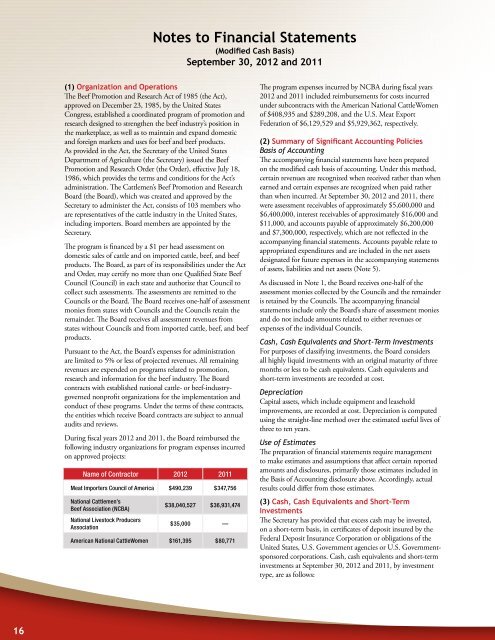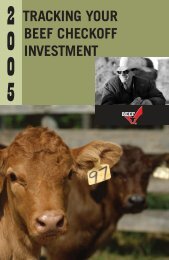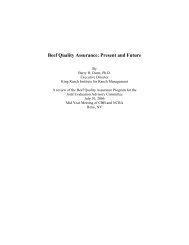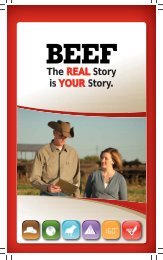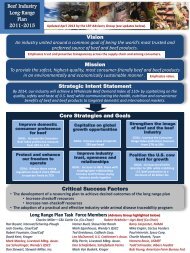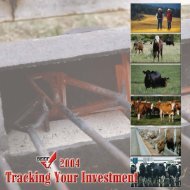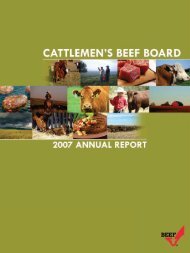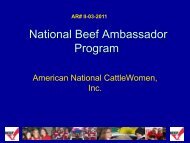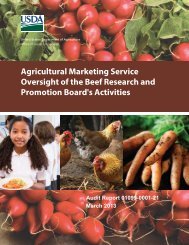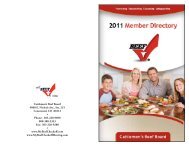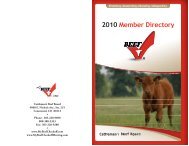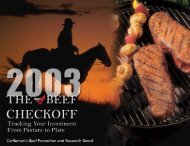2012 Beef Board Annual Report - Cattlemen's Beef Promotion and ...
2012 Beef Board Annual Report - Cattlemen's Beef Promotion and ...
2012 Beef Board Annual Report - Cattlemen's Beef Promotion and ...
Create successful ePaper yourself
Turn your PDF publications into a flip-book with our unique Google optimized e-Paper software.
Notes to Financial Statements<br />
(Modified Cash Basis)<br />
September 30, <strong>2012</strong> <strong>and</strong> 2011<br />
(1) Organization <strong>and</strong> Operations<br />
The <strong>Beef</strong> <strong>Promotion</strong> <strong>and</strong> Research Act of 1985 (the Act),<br />
approved on December 23, 1985, by the United States<br />
Congress, established a coordinated program of promotion <strong>and</strong><br />
research designed to strengthen the beef industry’s position in<br />
the marketplace, as well as to maintain <strong>and</strong> exp<strong>and</strong> domestic<br />
<strong>and</strong> foreign markets <strong>and</strong> uses for beef <strong>and</strong> beef products.<br />
As provided in the Act, the Secretary of the United States<br />
Department of Agriculture (the Secretary) issued the <strong>Beef</strong><br />
<strong>Promotion</strong> <strong>and</strong> Research Order (the Order), effective July 18,<br />
1986, which provides the terms <strong>and</strong> conditions for the Act’s<br />
administration. The Cattlemen’s <strong>Beef</strong> <strong>Promotion</strong> <strong>and</strong> Research<br />
<strong>Board</strong> (the <strong>Board</strong>), which was created <strong>and</strong> approved by the<br />
Secretary to administer the Act, consists of 103 members who<br />
are representatives of the cattle industry in the United States,<br />
including importers. <strong>Board</strong> members are appointed by the<br />
Secretary.<br />
The program is financed by a $1 per head assessment on<br />
domestic sales of cattle <strong>and</strong> on imported cattle, beef, <strong>and</strong> beef<br />
products. The <strong>Board</strong>, as part of its responsibilities under the Act<br />
<strong>and</strong> Order, may certify no more than one Qualified State <strong>Beef</strong><br />
Council (Council) in each state <strong>and</strong> authorize that Council to<br />
collect such assessments. The assessments are remitted to the<br />
Councils or the <strong>Board</strong>. The <strong>Board</strong> receives one‐half of assessment<br />
monies from states with Councils <strong>and</strong> the Councils retain the<br />
remainder. The <strong>Board</strong> receives all assessment revenues from<br />
states without Councils <strong>and</strong> from imported cattle, beef, <strong>and</strong> beef<br />
products.<br />
Pursuant to the Act, the <strong>Board</strong>’s expenses for administration<br />
are limited to 5% or less of projected revenues. All remaining<br />
revenues are expended on programs related to promotion,<br />
research <strong>and</strong> information for the beef industry. The <strong>Board</strong><br />
contracts with established national cattle‐ or beef‐industrygoverned<br />
nonprofit organizations for the implementation <strong>and</strong><br />
conduct of these programs. Under the terms of these contracts,<br />
the entities which receive <strong>Board</strong> contracts are subject to annual<br />
audits <strong>and</strong> reviews.<br />
During fiscal years <strong>2012</strong> <strong>and</strong> 2011, the <strong>Board</strong> reimbursed the<br />
following industry organizations for program expenses incurred<br />
on approved projects:<br />
Name of Contractor <strong>2012</strong> 2011<br />
Meat Importers Council of America $490,239 $347,756<br />
National Cattlemen’s<br />
<strong>Beef</strong> Association (NCBA)<br />
National Livestock Producers<br />
Association<br />
$38,040,527 $36,931,474<br />
$35,000 —<br />
American National CattleWomen $161,395 $80,771<br />
The program expenses incurred by NCBA during fiscal years<br />
<strong>2012</strong> <strong>and</strong> 2011 included reimbursements for costs incurred<br />
under subcontracts with the American National CattleWomen<br />
of $408,935 <strong>and</strong> $289,208, <strong>and</strong> the U.S. Meat Export<br />
Federation of $6,129,529 <strong>and</strong> $5,929,362, respectively.<br />
(2) Summary of Significant Accounting Policies<br />
Basis of Accounting<br />
The accompanying financial statements have been prepared<br />
on the modified cash basis of accounting. Under this method,<br />
certain revenues are recognized when received rather than when<br />
earned <strong>and</strong> certain expenses are recognized when paid rather<br />
than when incurred. At September 30, <strong>2012</strong> <strong>and</strong> 2011, there<br />
were assessment receivables of approximately $5,600,000 <strong>and</strong><br />
$6,400,000, interest receivables of approximately $16,000 <strong>and</strong><br />
$11,000, <strong>and</strong> accounts payable of approximately $6,200,000<br />
<strong>and</strong> $7,300,000, respectively, which are not reflected in the<br />
accompanying financial statements. Accounts payable relate to<br />
appropriated expenditures <strong>and</strong> are included in the net assets<br />
designated for future expenses in the accompanying statements<br />
of assets, liabilities <strong>and</strong> net assets (Note 5).<br />
As discussed in Note 1, the <strong>Board</strong> receives one‐half of the<br />
assessment monies collected by the Councils <strong>and</strong> the remainder<br />
is retained by the Councils. The accompanying financial<br />
statements include only the <strong>Board</strong>’s share of assessment monies<br />
<strong>and</strong> do not include amounts related to either revenues or<br />
expenses of the individual Councils.<br />
Cash, Cash Equivalents <strong>and</strong> Short‐Term Investments<br />
For purposes of classifying investments, the <strong>Board</strong> considers<br />
all highly liquid investments with an original maturity of three<br />
months or less to be cash equivalents. Cash equivalents <strong>and</strong><br />
short‐term investments are recorded at cost.<br />
Depreciation<br />
Capital assets, which include equipment <strong>and</strong> leasehold<br />
improvements, are recorded at cost. Depreciation is computed<br />
using the straight‐line method over the estimated useful lives of<br />
three to ten years.<br />
Use of Estimates<br />
The preparation of financial statements require management<br />
to make estimates <strong>and</strong> assumptions that affect certain reported<br />
amounts <strong>and</strong> disclosures, primarily those estimates included in<br />
the Basis of Accounting disclosure above. Accordingly, actual<br />
results could differ from those estimates.<br />
(3) Cash, Cash Equivalents <strong>and</strong> Short-Term<br />
Investments<br />
The Secretary has provided that excess cash may be invested,<br />
on a short‐term basis, in certificates of deposit insured by the<br />
Federal Deposit Insurance Corporation or obligations of the<br />
United States, U.S. Government agencies or U.S. Governmentsponsored<br />
corporations. Cash, cash equivalents <strong>and</strong> short‐term<br />
investments at September 30, <strong>2012</strong> <strong>and</strong> 2011, by investment<br />
type, are as follows:<br />
16


